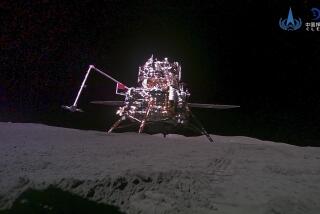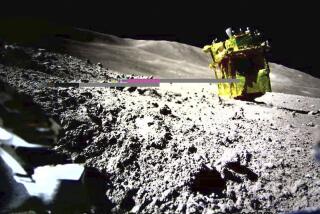Chinese rover ‘Jade Rabbit’ blasts off to the moon

- Share via
Welcome to the lunar club, China. A rocket carrying a moon rover blasted off from the Xichang Satellite Launch Center in Sichuan province, southwestern China at 1:30 a.m. local time Monday (9:30 a.m. Sunday Pacific time). The mission, called Chang’e 3, will be the first spacecraft to make a soft landing on the moon since 1976, when the Soviet Union sent up a sample-collecting mission called Luna 24.
Chang’e 3 follows two other Chinese lunar missions: Orbiter Chang’e 1 launched in 2007 to take a map of the entire lunar surface, and Chang’e 2 blasted off in 2010 to check out the moon before traveling to other points of interest in space.
The rover aboard the spacecraft is named Yutu, or Jade Rabbit, after the long-eared lunar companion of the moon goddess Chang’e. It’s bristling with a suite of instruments including panoramic cameras, ground-penetrating radar, an alpha particle X-ray spectrometer and an infrared spectrometer. The lander portion of Chang’e 3 has its own suite of instruments and reportedly includes an ultraviolet telescope.
Chang’e 3 is part of the second step in a three-step plan for lunar exploration. Down the line, Chinese officials say they want to build a mission that will collect samples from the moon and bring them back to Earth.
The spacecraft is also using an X-band observation system, which officials say could be useful for missions well beyond the moon.
“If we successfully use the X-band, in the future we can use this tracking network to perform a Mars mission,” Wu Fenglei, deputy director of system design at the Aerospace Control and Command Center, told CCTV.
If all goes as planned, the spacecraft should land on the moon in mid-December.
ALSO:
Meet the 28 neutrinos that are changing astronomy
Astronomers fooled by shiny, but tiny, black hole
These 15,000-year-old ‘fossil words’ reveal an Ice Age superfamily
Video: These fire ants act like a solid and a fluid
Cute yet creepy: Somersaulting robots can self assemble
Gold mine experiment finds no dark matter -- so why are scientists happy?







